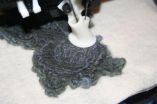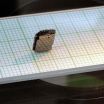(Press-News.org) PITTSBURGH—Soft and cuddly aren't words used to describe the plastic or metal things typically produced by today's 3D printers. But a new type of printer developed by Carnegie Mellon University and Disney Research Pittsburgh can turn wool and wool blend yarns into fabric objects that people might actually enjoy touching.
The device looks something like a cross between a 3D printer and a sewing machine and produces 3D objects made of a form of loose felt. Scott Hudson, a professor in CMU's Human-Computer Interaction Institute who developed the felting printer with Disney Research support, said the results are reminiscent of hand-knitted materials.
"I really see this material being used for things that are held close," Hudson said. "We're really extending the set of materials available for 3D printing and opening up new possibilities for what can be manufactured."
That could include apparel, accessories such as scarves and hats and even Teddy Bears. It also might be used to produce parts for so-called "soft robots" – robots designed to touch or be near people. Hudson will discuss the felting printer April 28 at the CHI Conference on Human Factors in Computing Systems in Toronto.
Like other 3D printers, Hudson's machine can make objects by working directly from computerized designs. It thus can be used for rapid prototyping of objects and to customize products.
In fact, the operation of the machine is similar to Fused Deposition Modeling, or FDM, the most common process used in low-end 3D printers. In a FDM printer, melted plastic is extruded in a thin line into a layer; subsequent layers are added to achieve the object's desired shape, with the layers adhering to each other as the plastic cools.
In the felting printer, however, the printer head feeds out yarn instead of lines of melted plastic. A barbed felting needle attached to the printer head then repeatedly pierces the yarn, dragging down individual fibers into the yarn in the layers below, entangling the fibers and bonding the layers together.
Hudson said the printer doesn't achieve the same dimensional accuracy as conventional 3D printers because the yarn is much thicker than the layers of plastic deposited in FDM printing. The felt also is not as strong as typical fabric, he noted, so if the soft objects are to be attached to a hard object, a layer of nylon mesh fabric must be incorporated during the printing process. This provides reinforcement to prevent the material from ripping away at the attachment point.
Hudson demonstrated techniques for bridging between the soft and hard materials, for manipulating the degree of stiffness in the soft objects and for incorporating electronic components.
These techniques require some assembly of objects because the printer now produces only fabric objects. But Hudson said it should be possible to design a printer that could produce both fabric and plastic elements in a single fabrication.
"A number of researchers are looking at mixed materials in 3D printing," he added. "That's one of the most interesting challenges now."
INFORMATION:
A video showing how the felting printer works and how it might be used is available online at http://www.disneyresearch.com/project/printed-teddy-bears/
About Carnegie Mellon University
Carnegie Mellon is a private, internationally ranked research university with programs in areas ranging from science, technology and business, to public policy, the humanities and the arts. More than 12,000 students in the university's seven schools and colleges benefit from a small student-to-faculty ratio and an education characterized by its focus on creating and implementing solutions for real problems, interdisciplinary collaboration and innovation. A global university, Carnegie Mellon has campuses in Pittsburgh, Pa., California's Silicon Valley and Qatar, and programs in Africa, Asia, Australia, Europe and Mexico.
About Disney Research
Disney Research is a network of research laboratories supporting The Walt Disney Company. Its purpose is to pursue scientific, and technological innovation to advance the company's broad media and entertainment efforts. Disney Research is managed by an internal Disney Research Council co-chaired by Disney-Pixar's Ed Catmull and Walt Disney Imagineering's Bruce Vaughn, and including the directors of the individual labs. It has facilities in Los Angeles, San Francisco, Pittsburgh, Boston and Zurich. Research topics include Computer Graphics, Video Processing, Computer Vision, Robotics, Radio and Antennas, Wireless Communications, Human-Computer Interaction, Displays, Data Mining, Machine Learning and Behavioral Sciences.
Carnegie Mellon-Disney researcher invents 3D printing technique for making cuddly stuff
Printer uses needle to turn layers of wool yarn into loose felt
2014-04-28
ELSE PRESS RELEASES FROM THIS DATE:
Beyond graphene: Controlling properties of 2D materials
2014-04-28
The isolation of graphene at the University in 2004 led to the discovery of many other 2D crystals. While graphene has an unrivalled set of superlatives, these crystals cover a large range of properties: from the most conductive to isolating, from transparent to optically active.
The next step is to combine several of these crystals in a 3D stack. This way, one can create 'heterostructures' with novel functionalities – capable of delivering applications as yet beyond the imagination of scientists and commercial partners.
The first examples of such heterostructures already ...
One cell type may quash tumor vaccines
2014-04-28
(PHILADELPHIA) -- Most cancer vaccines have not lived up to their promise in clinical trials. The reason, many researchers suspect, is that the immune cells that would help the body destroy the tumor – even those reactions boosted by cancer vaccines – are actively suppressed. Now, researchers at Thomas Jefferson University have found that a single cell type is actively suppressed in several experimental cancer vaccines, paving the way toward methods to break suppression and improve the effectiveness of cancer vaccines. The work was published this week online in the European ...
Ames Lab researchers see rare-earth-like magnetic properties in iron
2014-04-28
Scientists at the Department of Energy's Ames Laboratory have observed magnetic properties typically associated with those observed in rare-earth elements in iron. These properties are observed in a new iron based compound that does not contain rare earth elements, when the iron atom is positioned between two nitrogen atoms. The discovery opens the possibility of using iron to provide both the magnetism and permanence in high-strength permanent magnets, like those used in direct-drive wind turbines or electric motors in hybrid cars. The results appeared in Nature Communications.
In ...
Estimating baby's size gets more precise
2014-04-28
New Michigan State University research aims to help doctors estimate the size of newborns with a new set of birth weight measurements based on birth records from across the country.
"More than 7 million records were reviewed," said Nicole Talge, an assistant professor in MSU's Department of Epidemiology and Biostatistics, who co-led the study which is now available in the journal Pediatrics.
"Our research looked at live births in the United States during 2009-2010 and using a newly developed method, corrected unlikely gestational ages during that time. This led to changes ...
Gulf War illness: New report lauds treatment research, confirms toxic causes
2014-04-28
Progress has been made toward understanding the physiological mechanisms that underlie Gulf War illness and identifying possible treatments, according to a report released Monday by a Congressionally mandated panel of scientific experts and veterans.
Treatment research has increased significantly since 2008, and "early results provide encouraging signs that the treatment goals identified in the 2010 Institute of Medicine report are achievable," the Research Advisory Committee on Gulf War Veterans' Illnesses (RAC) said in a report presented Monday to VA Secretary Eric ...
Studies offer insight on how to improve kidney and liver transplantation
2014-04-28
The quality of kidney and liver donations is fundamentally important for the longevity of transplants and the health of recipients. That's why it's critical to know which organs are suitable for transplantation, as well as to use techniques that preserve an organ's function after donation. Several studies published in the BJS (British Journal of Surgery) address these issues and offer ways to maximize the use of donated organs.
In the first study, Rajeev Desai, MRCP, of NHS Blood and Transplant, in the UK, led a team that assessed transplants from 17,639 donors, including ...
R.I. nitrogen cycle differs in bay and sound
2014-04-28
PROVIDENCE, R.I. [Brown University] — Rhode Island's geography is famously small, but new measurements of the nitrogen cycle in its waterways suggest that even over a small distance, differences can be huge. Scientists report that the nitrogen-converting process anammox is almost completely absent in Narragansett Bay, even though it is going strong in Rhode Island Sound only 15 miles off the coast.
The novel and somewhat surprising finding, documented in the journal Limnology and Oceanography, raises intriguing questions about why the bay seems inhospitable to an important ...
Breast cancer patients place huge emphasis on gene expression profiling test
2014-04-28
TORONTO, April 28, 2014—Gene expression profiling tests play a critical role when women with early-stage breast cancer decide whether to have chemotherapy, but many of them do not fully understand what some of the test results mean, new research suggests.
Current guidelines for treating early-stage breast cancer—cancer that has not spread to nearby lymph nodes or other parts of the body—result in thousands of women receiving chemotherapy without benefitting from it.
A gene expression profiling test can help differentiate women who might benefit from chemotherapy versus ...
Increasing sugar concentration in tomato juice
2014-04-28
TOKYO, JAPAN – To increase the sugar concentration and resulting marketability of tomato juice, growers have traditionally used techniques such as subjecting plants to salt and water stresses. In a new study published in HortTechnology (February 2014), Ken Takahata and Hiroyuki Miura from Tokyo University of Agriculture reported on a prototypic method known as "basal wire coiling" that shows potential as a simple and effective method for increasing the sugar concentration in tomato fruit juice.
"We investigated whether coiling wire around the lower part of the plant stems ...
Impact of pelargonic acid for weed control in yellow squash
2014-04-28
DURANT, OK – Growers who produce squash for market are increasingly interested in using more natural herbicides that are also effective in providing season-long weed control, but the options for controlling annual broadleaf weeds in summer squash are currently limited. The authors of a new study say that both organic and conventional producers will benefit from the identification of natural herbicides that effectively provide postemergent weed control. Charles Webber III, Merritt Taylor, and James Shrefler conducted a research study published in HortTechnology to determine ...
LAST 30 PRESS RELEASES:
Sophisticated neuroimaging reveals PTSD in WTC responders is linked to measurable physical changes in brain structure
Health policy experts identify promising strategies for providing health care to homeless people
Study explores role of neutrophils in canine atopic dermatitis
Mayo Clinic researchers develop AI-ECG model to diagnose liver disease earlier
Heavy menstruation common among teenage girls – questionnaire reveals risk of iron deficiency
New study explores why open water swimming feels so powerful for midlife women
In echo of Jurassic Park, mosquitoes capture entire ecosystems in their blood meals
Marty Cooper, Illinois Tech Alumnus and ‘Father of the Cell Phone,’ Receives 2025 Marconi Society Lifetime Achievement Award
How to reduce the risk of lymphedema
NEJM Evidence and CIDRAP announce Public Health Alerts
New fossil study illuminates on the evolutionary success of frogs
Patient-specific human liver model to understand disease mechanisms
Confused by the doctor's questionnaire? U of A study suggests it's common
How do brains stay stable, and when might a dose of flexibility be helpful?
mRNA revitalizes aging immune systems—the liver as a fountain of youth
Rural-urban differences in the prevalence of chronic pain among adult cancer survivors
Food insecurity, burnout, and social isolation among resident and fellow physicians
How do spinal cord injuries heal?
Detailed cell map unlocks secrets of how reproductive organs form
Large language models unleash AI’s potential for autonomous and explainable materials discovery
Gut bacteria have evolved rapidly to digest starches in ultra-processed foods
New risk score helps predict pancreatic cancer recurrence
New evidence challenges understanding of Parkinson’s disease
A new study reveals how embryos and the uterus “talk” during implantation
Cedars-Sinai reports heart attacks, general illness spiked after LA fires
PolyU develops ultra-stable, mucus-inspired hydrogel to boost gastrointestinal wound healing
Flour choice shapes sourdough microbial communities
Can a retinal implant reverse macular degeneration?
Feeding fungi plant remnants produces tasty protein to fortify vegan, vegetarian diets
New tech reduces false positives from breast ultrasounds
[Press-News.org] Carnegie Mellon-Disney researcher invents 3D printing technique for making cuddly stuffPrinter uses needle to turn layers of wool yarn into loose felt




